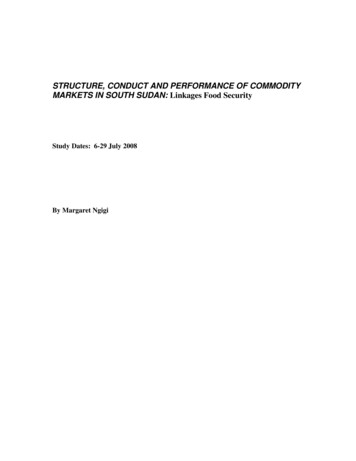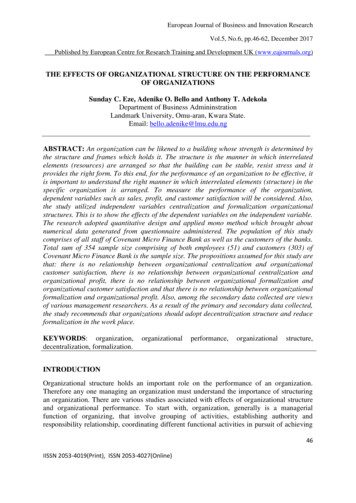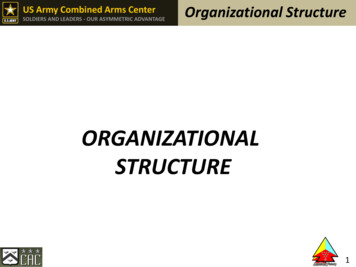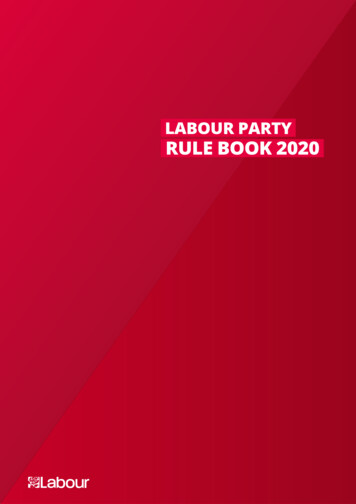
Transcription
STRUCTURE, CONDUCT AND PERFORMANCE OF COMMODITYMARKETS IN SOUTH SUDAN: Linkages Food SecurityStudy Dates: 6-29 July 2008By Margaret Ngigi
Acronyms and Abbreviations . ivExecutive Summary . vi1.0.Introduction. 1Conceptual Background: Causal Linkages between Market Performance and FoodSecurity . 22.0. Background information. 32.1Context of the study . 42.2Geographical scope of the study . 53.0. Methods. 64.0. Findings of the Study. 84.1Socio-economic profile of survey respondents . 84.2Commodities and Sources of Supplies . 114.3The structure of transportation and storage . 134.4Organization of Marketing . 144.4.1Cross-border traders . 174.4.2Domestic producers . 174.4.3Transportation . 174.4.4Brokers . 194.1.5Loaders/off-loaders/Porter . 194.1.6Wholesaler . 194.5Market concentration . 204.6Conduct of Commodity Procurement and sale . 224.6.1Market Information Search conduct . 224.6.2Price Discovery . 234.7Market performance . 234.7.1Marketing Costs and Margins . 234.8Marketing constraints. 274.9Livestock Markets . 304.9.1Livestock Marketing Constraints . 334.10 Fish markets . 345.0. Summary of Findings. 356.0. Proposal for a monitoring plan. 36ANNEX II: Terms of Reference . 43ANNEX II: Theoretical Framework . 46Table 1. Major market centers covered in the study . 7Table 2. Sample and composition . 7Table 3 summary statistics of the traders Socio-economic attributes . 8Table 4 Major commodities traded in the markets and their major origins . 11Table 5. Major commodities flowing into the four urban markets from local production 12ii
Table 6 average duration stock is held in store by retailers and wholesaler . 13Table 7 Major means of seeking price information . 22Table 8. Traders mode of seeking purchase price information . 23Table 9. Price determination methods: negotiation or setting . 23Table 10. Typical time costs (in number of days), by road, from Kampala and Khartoumto the respective Urban markets . 25Table 11 Estimated incidental Costs for procuring a metric Ton maize flour fromKampala and moving it to Rumbek . 25Table 12 Estimated incidental Costs for procuring a metric Ton Sugar from Kampala andmoving it to Rumbek . 25Table 13 Estimated incidental Costs for procuring a metric Ton Sorghum fromKhartoum and moving it to Rumbek . 26Table 14 Estimated incidental Costs for procuring a metric Ton Wheat Flour fromKhartoum and moving it to Rumbek . 26Table 15. Estimated incidental Costs for procuring a metric Ton Wheat Flour fromKhartoum and moving it to Rumbek . 27Table 16. Hunger season for the respective markets . 31Table 17. Travel time taken by seller s supplying the respective markets . 32Table 18 cost of fishing boats and accessories . 35Table 19. Market structure, Conduct and Performance variables , Implications for foodsecurity and monitoring indicators. 39Figure 1 A Map of South Sudan showing the respective position of the markets coveredin the study . 6Figure 3. Sample distribution by number of years experience in trade. . 10Figure 4. Marketing Channel for Agricultural commodities flowing from Khartoum andKampala sources . 15Figure 5. Marketing Channel for Agricultural commodities flowing from domesticproduction . 16Figure 6. Number and size distribution of grain traders . 21Figure 7. Number and size distribution of sorghum traders . 21Figure 8. Number and size distribution of maize meal traders . 22Figure 9 major components of food commodity prices . 24Figure 10 Summary of the of relative marketing constraints faced by traders serving Jubamarket . 29Figure 11 Summary of the of relative marketing constraints faced by traders servingRumbek market . 29Figure 12 Summary of the of relative marketing constraints faced by traders serving Waumarket . 30Figure 13 Summary of the of relative marketing constraints faced by traders servingMalakal market . 30Figure 14. Physical flow of livestock through the marketing channel . 31iii
Acronyms and AbbreviationsCARCentral African RepublicCBOSCentral Bank of SudanCLIMISCrop and Livestock Market Monitoring SystemCPAComprehensive Peace AgreementDRCDemocratic Republic of CongoFAOFood and Agricultural Organization of the United NationFEWS NETFood Early Warning Systems NetworkGOSSGovernment of South SudanIDPsInternally Displaced PersonsMAFMinistry of Agriculture and ForestryMISMarket Information SystemSPSudan PoundSSSouth SudanUshUganda Shillingiv
ACKNOWLEDGEMNTI gratefully acknowledge the support and assistance of many people in South Sudan whoplayed a role in this work. Many thanks go to staff of the Ministry of Agriculture andForestry (MAF) in Juba, Rumbek Wau and Malakal for their cooperation and assistanceduring study. I gratefully appreciate the assistance Angelo Joseph Lemor of MAF Jubaand Everlyn Muchomba of FEWS NET who were instrumental in facilitating this study.v
Executive SummarySeveral factor highlight food market risks and uncertainties for urban consumers in SouthSudan. First, the South Sudan’s agriculture is yet to revive appreciably from severedisruptions caused by over two decades of civil conflicts. Secondly, rural and urbanareas are poorly integrated, mainly due to a virtual absence of transport andcommunication infrastructures, as well as due to civil insecurities. As a result, majorurban markets are heavily dependent on imports of most basic food staples. The majorsupply sources are North Sudan and Uganda. Khartoum and Kosti are the major centersof procurement transactions of North-South Sudan trade, while Kampala is the majorcentre of cross-border transaction of commodities flowing from Uganda. Together,North Sudan and Uganda account for the bulk of sugar, maize flour, rice, onion, wheatflour and sorghum sold in the four markets. This heavy dependence on importation offood supplies implies that any adverse events, both market and non-market, on the NorthSouth Sudan, and/or the Kampala-South Sudan trade flows increases the vulnerability ofa large percentage of urban householdsIn order to focus its activities on promoting the provision of up to-date information onfood supply prospects and their implication on food security, the FEWS NET SouthSudan office has identified the need for an effective market monitoring system. Thisreport is intended to contribute towards a better understanding of South Sudan’sagricultural commodity market systems. The focus is on structure, conduct andperformance of agricultural marketing systems in four major urban markets, namely Juba,Rumbek, Wau, and Malakal. Major marketing channels and market participants arecharacterized through a rapid diagnostic survey involving semi-structured questionnairesand informal interviews of key informants, as well as direct observation of markettransactions.The findings show that North-South Sudan and Kampala-South Sudan trade arecharacterized by three distinct marketing channels. One involves large-scale traders whomove large volumes storable food commodities ―mainly grain cereal; grain legumes;maize and wheat flour; and sugar― using large capacity hired trucks. Goods fromKhartoum are also moved by barges down river Nile. Another channel involves smallscale traders, who individually face quantity constraints in hiring entire trucks, but whoare able to pool together to share transport trucks. The third channel involves transportertrader, i.e., truck-owners combining transportation, buying and reselling functions. Thisthird channel is common with bulky perishable commodities, especially bananas, onionand potatoes. Internal commodity sources are also important in supplying the urbanmarkets. However, they are still disadvantaged by relatively poorer road transportinfrastructures, which pose major operational problems.The structure of supply in the four markets is closely linked to the structure andconstraints of transportation. Because the trunk roads connecting the four urban marketswith major supply sources are impassable during rainy seasons, commodity procurementby road tends to be concentrated in the dry season. In contrast, water transportation tendsto be concentrated in the rainy season when the river’s water volume is adequate to allowbarge movement. Malakal and Juba, which are well-positioned for river transportationvi
during the rainy season, do not simultaneously have access to road and watertransportation. Therefore, do not present alternative modes.The markets are concentrated. Certain infrastructural constraints have made thisinevitable; the long distance haul on roads that become impassable in the rainy seasonsnecessitates the operation of large businesses for better management of procurementschedules. Concentration, however, underlines the importance of an effective and quickinformation system to provide up to date information to traders so that they can quicklyrespond when adjustments are required. It is essential that the traders should get timelyinformation about impending problems, the alternatives and possible solutions. This waythey can benefit the consumer markets more and sustain their businesses better.Trader face numerous and varied challenges. The challenges range from infrastructuralweaknesses that create uncertainties to traders’ ability to supply the market and distributethe commodities effectively. Long distances of movement, poor road infrastructure, civilinsecurity and multiple formal and informal taxes are the major limiting factors.The study concludes that the observed marketing system relates to food security throughavailing food supplies to the urban markets, as well as enhancing market participant’saccess to food through job creation and income growth. Performance of these two foodsecurity dimensions depend on a number of factors, including traders’ level of access tocommodity transportation services; the condition of transport and communicationinfrastructure (transportation links); availability of storage; transaction costs; marketingrisks due to civil insecurity (may be too risky for individual private entrepreneurs); andcost of protecting the commodities. These are broad aspects of the market that should bemonitored.It is also recommend that efforts to establish effective monitoring systems should involvethe active engagement of the newly established MIU in MAF for internal capacitybuilding and sustainability.vii
1.0IntroductionThe influence of aggregate food supply on market prices and, hence, on food access iswell-recognized. Food supply and price levels have traditionally been the dominantindicators of food access. However, lessons derived from experiences in developingcountries suggest the need to broaden this view of the influence of market on foodsecurity. The need to incorporate other market-related aspects is becoming increasinglyclear. Observations show that food access problems experienced in most parts ofdeveloping countries are only partially attributable to levels of aggregate food suppliesand prices. Rather, food access problems are also caused by inefficiencies of marketingsystems. It is not uncommon for the countries to have localized food surpluses and lowprices, while other parts suffer food deficits. It is also common for periods of foodsurpluses to be followed by transitory food insecurities. Such situations suggest that amore broad-based view of marketing mechanisms is crucial in identifying criticalmarketing-related food-access-impediments. They also suggest the need to incorporateadditional market-related indicators for use in monitoring for food security. Furthermore,the experiences imply that the indicators should be defined within a specific context.This report is the outcome of a study commissioned by the Famine Early WarningSystems Network (FEWS NET). Its overall goal is to contribute towards a betterunderstanding of South Sudan’s agricultural commodity market systems. It is based onthe structure-conduct-performance (S-C-P) model of market analysis. The choice of themodel reflects a shift from FEWS NET’s traditional focus on only one aspect of foodsecurity― the household’s food access. The FEWS NET Market Guidance No2 of May2008, notes that the combined effects of structure, conduct, and performance (S-C-P) of amarketing system have significant consequences for a country’s or region’s food security.Accordingly, the Guidance recommends the use of the S-C-P model in order to bettercontribute to food early warning analysis. This report focuses on food marketing systemsin four urban markets of South Sudan (SS), namely Juba; Rumbek; Wau; and Malakal.The aim is to enhance the understanding of market structure, conduct and performance ofmajor food commodities in the four markets. Its expected outcome is a market monitoringplan for food security analysis for use in early warning for the four urban areas. Insummary, the study’s terms of reference are to: (1) confirm the selection of commoditiesmost relevant to food security (2) identify and characterize a set of key market networksfor food, cash crops and livestock (3) characterize market structure and conduct as wellas indicators to be used in monitoring for food security analysis purposes (4) identifyNorth-South Sudan and other cross border market linkages (5) give implications ofmarket performance on food security. The detailed terms of reference are given inAnnex1.The rest of the report is organized as follows: sub-section 0 explores conceptual linkagesbetween market performance and food security; Section 2.0 presents the background andcontext of the study; Section 3.0 focuses on describing the method used; Section 4.0presents the study’s findings; Sub-section 5.0 presents summary of findings; while 6.0present a proposal of monitoring plan1
Conceptual Background: Causal Linkages between Market Performance and FoodSecurityAn efficient food marketing system is a crucial component in enhancing food security. Thefunctioning of food markets has significant influence on all dimensions of food security,which include food availability, accessibility, and utilization. The causal linkages betweenmarketing and food security are complex. A number of the linkages operate through theinfluence of the marketing system on production incentives. Production beyond a farmhousehold’s consumption needs is heavily dependent on market access. The extra costsand risks of investing heavily in labor, capital, and productivity-enhancing technologies arejustifiable only if output markets are ensured. Hence, one consequence of poor marketaccess is that farm households have little incentives to fully exploit their land and laborpotentials and are, therefore, constrained to subsistence farming of a few basic staples.This, in turn, limits a country’s or region’s capacity to ensure that all of its people havesufficient physical and economic access to food. Conversely, an effective food outletaccess contributes positively by facilitating a more profitable utilization of labour and landpotentials. The resultant higher returns lead to enhanced cash-earning capacity and a widerfood commodity base. Increased rural-households’ buying capacities, in turn, provides thenecessary monetary support for rural commerce. At the same time, crucial linkages ofagriculture to non-farm sectors, both in the rural and urban areas, are created and enhanced.The income generated, coupled with change in demand as income rise, provides essentialdrive for increased investment in high-value agricultural commodities and products, as wellas potential to expand the geographical market scope to include regional and internationalmarkets. All this has far reaching consequences for the development of investments, jobopportunities outside agriculture, diversified livelihoods and, hence, on enhancement offood security.Other linkages operate through operational and pricing efficiencies of the marketingsystem. These relate to how satisfactory the movement of food is, from supply sources tothe consumer. The effectiveness of food supply chains can influence food security invarious ways. Food availability may be influenced through physical food losses andwastages at various marketing channel levels. Accessibility may be influenced throughoperations that increase the share of consumer food cost that is accounted for by marketingcost. Such operations include multiple handling as units of products are built into larger orsubdivided into smaller lots, in processes entailing lengthy marketing channels and, hence,high marketing costs. Accessibility may also be influenced through market structures thatallow extraction of monopoly profits, rent-seeking, as well as price sensitivities that favourmarket middlemen but that are disadvantageous to consumers and producers. Middlemenbiased price sensitivities mean that when supply and or market cost pressures pushes costsup, the increase is rapidly passed on to consumer. Conversely, when food demandpressures drive consumer prices up, the price increases are not rapidly passed down toproducers. Inadequate or lack of appropriate storage facilities may constrain the system’scapacity to hold stock from peak supply periods in correspondence to even demandrequirements through crop production cycles. Such storage constraints are oftenmanifested in large seasonal price variations, and hence, instabilities in aggregate foodsupplies. Wide seasonal price variations may also be the result of poor market information2
on market supply and demand condition, and hence, prices. Poor market information andtransportation system may fragment the market causing wide spatial price variationsWhat all this suggests is that a good food security monitoring plan requires to be designedin such a way as to capture the varied aspects of the food marketing chain that influencefood security. These include the systems abilities to: offer sufficient incentives for farmhouseholds to produce marketable surpluses; distribute food from surplus to deficit area;stockpile in periods of plenty for redistribution in periods of scarcity; collect anddisseminate market information.2.0Background informationIn early 2000s South Sudan (SS) emerged from an armed conflict that had prolonged forover two decades. The end of the armed struggle was signalled by signing of theComprehensive Peace Agreement (CPA) in January 2005. This signified the beginning ofa new era in the development of (SS). During the years of conflict, agricultural productionwas disrupted, while formal markets became few, isolated, and small mainly due topolitically restricted population movements, non-exist market infrastructure, and lack of acommon currency, and of income-earning opportunities. Informal exchange mechanisms,mainly in form of barter trade, dominated.The signing of the CPA triggered social-economic changes. Since then, large populationsof South Sudanese, who during the years of conflict lived as refugees in neighbouringcountries, have returned. At the same time, large numbers of internally displaced people(IDPs) have resettled in areas that were inaccessible during the years of conflict. By theyear 2005, the population of South Sudan was estimated to be 9.5 million and was expectedto increase to 12 million with the return of remaining refugees. The government of SouthSudan (GOSS) has embarked on major efforts to rehabilitate and rebuild social andphysical infrastructures destroyed during the protracted years of conflict. In addition, theCentral Bank of Sudan (CBOS), in 2007, introduced a common currency—the Sudanesepound (SDG)—thus addressing the transactional problems of dealing with multiplecurrencies as was the case before. This has been accompanied by the establishment of anumber of banks in major urban areas. Peace, in combination with these changes, hasfacilitated the opening-up of SS to commercial activities, among them trade andagricultural marketing. Rural areas are slowly becoming linked with urban markets,especially for sale of livestock, groundnut, sorghum, sesame, millet and a variety of freshfruits and vegetables. However, prices fluctuate heavily. This is mainly because roadslinking urban markets with food commodity supply sources become impassable during therainy season leading to shortages of commodities. Meanwhile, barter trade is still commonin rural areas.As economic activities in SS continue to increase and diversify, there is need to develop anagricultural market monitoring system that can provide regular information on prevailingsupply and demand conditions, as well as information on concerns and issues hinderingeffective operations of the markets. Apart from informing early warning, the provision of3
such information has the potential to contribute significantly towards identification ofserious barriers to efficient marketing, as well as in identification of new technologies orinstitutional arrangements appropriate in enhancing market performance. This is crucial asthe government of South Sudan (GOSS) strives to transform the area’s agriculture into amore market-oriented operation. Indeed, the development of market-oriented domesticagriculture presents SS with a strategy for improved food security through: increased anddiversified food supplies; increased rural employment and income-generating activities;and, production of exportable surpluses.Significant market opportunities for locally produced agricultural commodities exist bothwithin SS and in the neighboring countries. South Sudan’s geographical position—bordering Kenya, Uganda, the Democratic Republic of Congo (DRC), the Central AfricanRepublic (CAR), and Ethiopia — combined with its abundant natural resources, suitableagro-ecological conditions, and rich biodiversity, creates strong potential for marketintegration of its agricultural sector with East, Central, and Northern Africa, as well as therest of the world. Currently substantial amounts of sugar, rice, maize flour and wheat flourconsumed in major urban areas of SS is sourced from Uganda and Northern Sudan.Addressing technical and socioeconomic constraints to local agricultural production, and tourban market access, presents major market opportunities for rural South Sudan as locallygrown commodities substitute for those sourced outside. In the medium term, there areprospects for increased local supply of a variety of horticultural commodities and rice,especially with full implementation of four national irrigation schemes. Rejat, Kabo, andJabel Lado horticultural Schemes, estimated to be 43,000; 25,000; and 20,000 acres,respectively, are under way for the production of tomatoes, cabbages, okra, and watermelons, while Aweil rice Scheme, which is about 11,000 acres, is expected to increaselocal supply of rice.The crucial role of market-oriented agriculture and, hence, an efficient agriculturalmarketing system, is also apparent from the pivotal role that agricultural growth must playin driving overall economic growth of SS. Like is the case for many other developingcountries, GOSS has identified agricultural growth as a major route to overall economicdevelopment. The Food and Agricultural Policy Framework prepared by the Ministry ofAgriculture and Forestry (MAF) in 2007 notes that growth in the agricultural sector has thepotential to have an impact on peoples’ livelihoods and the economy’s prosperity. Theframework has set a strategy of transforming agriculture and forestry services into a drivingforce of the economy in achieving a number of objectives, among them: (1) to achieve foodsecurity; (2) promote poverty reduction; and (3) contribute to GDP. As part of theseobjectives is the desire to produce marketable surpluses to serve local, regional andinternational markets. These objectives can be realized only in conjunction with anefficient marketing system.2.1 Context of the studyA workshop organised by the Ministry of Agriculture and Forestry (MAF) in collaborationwith the Food and Agricultural Organisation of United Nation (FAO), in December 2007 to4
discuss the way forward in establishing a crop and livestock market monitoring system(CLIMIS), noted that collection and sharing of market data in SS is faced with a lot ofchallenges. These include uneven data collection, lack of a framework for a coordinatedand unified data collection, and non-existenc
the structure-conduct-performance (S-C-P) model of market analysis. The choice of the model reflects a shift from FEWS NET's traditional focus on only one aspect of food security ― the household's food access. The FEWS NET Market Guidance No2 of May 2008, notes that the combined effects of structure, conduct, and performance (S-C-P) of a










